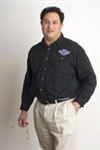Removing Toxic Black Mold
By Jeffrey Cohn
Toxic mold is often a black or green substance, slimy in texture that causes allergic reactions, sickness, and other health hazards in humans. Toxic mold is also known simply as black mold. Its scientific designation is Strachybotrys atra (or Strachybotrys chartarum). A self-reproducing fungus, asexual by nature, is able to multiple rapidly when it inhabits dark, damp and humid environments.
Toxic black mold feeds on porous organic compounds rich in cellulose. For home and business owners, this is a very dangerous proposition, as this particular genus of fungus contains over fifty unique species and is widespread in distribution.
Mold is commonly found outdoors. However, when mold spore counts are higher inside than their juxtaposed outdoor environment, indoor air quality can become a health risk for inhabitants. Mold spores are seeds which usually travel through the air in search for a habitable environment to grow and thrive. Colonies of mold can grow between 24 and 48 hours of an environment’s exposure to water or moisture.
Many rooms and areas in the home or office are naturally damp, dark and humid. Kitchens, bathrooms, attics, crawlspaces and basements are all common places to find toxic black mold. It is unwise for home or business owners to attempt to touch or clean toxic black mold, as improper handling could potentially cause distribution of mold spores throughout the rest of the building.
Mold spores will travel anywhere. However, spore are most dangerous when they enter HVAC and ventilation systems. Once a colony of mold begins to grow in ducts and vents within a building, the air quality will deteriorate much faster and health risks will become more inherent. Mold must be approached safely and properly to prevent cross contamination in HVAC systems and other areas.
Toxic black mold is dangerous to people and animals with and without allergies to mold. Those without allergies can experience nasal congestion, eye irritation, skin irritation, coughing and wheezing when exposed to the toxic fungus. People with mold allergies will experience more harmful side effects like deterioration of regular lung functions, shortness of breath, and high fevers. Patients with immune deficiencies are at even greater, potentially fatal, health risks.
The Environmental Protection Agency offers many tips on how to handle toxic black mold. However, the Institute of Inspection Cleaning and Restoration Certification (IICRC) contends that mold remediation specialists should be called in if the affected area exceeds three square feet.
The IICRC is a governing body in the water damage and mold remediation industry that creates and governs guidelines to ensure safe and healthy mold removal. The IICRC S520 Guidelines for Mold Removal outline procedures like containment, use of HEPA filtered equipment, standardized Personal Protective Equipment, and other guidelines to ensure the safety of the mold removal technicians as well as the home or business owners who will return to the property after the remediation process has completed.
Trusting the right Mold Removal Contractor can take a lot of work. Mold contractors who promote the use of independent industrial hygienists to conduct mold spore testing before and after the mold removal project should be highly considered. Testing done by the mold contract themselves causes an inherent conflict of interest, risking a test result that can benefit only the contractor themselves.
Also, Mold contractors who are individually and collectively certified through the IICRC are highly qualified to perform any mold remediation project. Home and business owners should not hesitate to ask for proof on insurance and bonds to protect their assets and their families and employees respectively.
About the Author
|
 | Jeffrey Cohn, SI Restoration
2312 Eskow Ave
Halethorpe, MD 21227
888-980-6776
Contact Author: request info
If you would like to re-print this article, please contact the author.
|
|
|
|
|
|
|
|
|
|
|
|
|
|
Editorial Disclaimer: The views expressed in articles published on this website are those of the authors alone. They do not represent the views or opinions of this website or its staff. The articles on this site do not constitute a recommendation or endorsement with respect to any views, company, or product. Authors affirm that article submissions are their original content or that they have permission to reproduce.
|
|